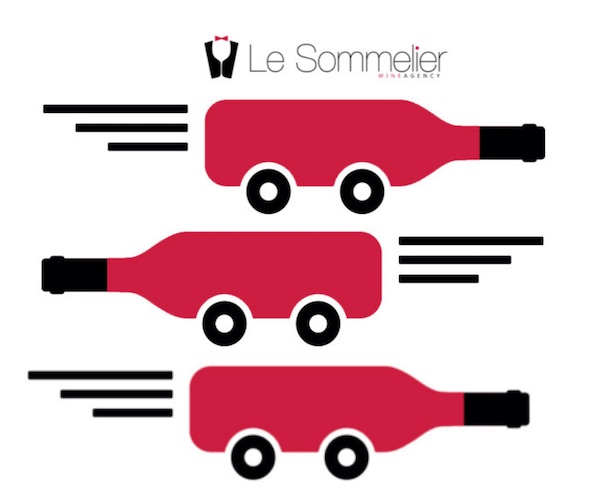Inside the bottle-lined walls of Loop Line, I met with Wolfgang Klotz of Cantina Tramin, to discuss the incredible alpine wines of Alto Adige. Alto Adige finds itself in a unique terroir, with dozens of microclimates, from steep vineyards 800m above sea level, to valley floor plantings. Growers can host everything from Gewürztraminer and Chardonnay, to Pinot Noir and Cabernet Sauvignon. Also known as Südtirol, Trentino Alto Adige borders on modern day Austria, and has been warred over by Romans, Germanic tribes, and the powers of the great World Wars. The culture of Südtirol/Alto Adige reflects that tumultuous history in its culture, food, and wine. There aren’t many places where you might hear “benvenuto” and “danke schön” in the same sentence.

Wolfgang Klotz at Loop Line
Wines from Alto Adige are scarce in Ontario; right now, the LCBO lists less than a dozen in stock, the majority being Pinot Grigio. Pinot Grigio is the grape most Ontarian’s would associate with the region, and it was my first experience with Alto Adige personally. Pinot Grigio here is generally made in a richer, more expressive style, with character and concentration, and while producing excellent Pinot Grigio, Tramin earned its fame with Gewürztraminer.
It’s not a surprise the classic aromatic varietal finds a natural home in the cool alpine terroir, with mentions of “Traminer” in the region dating as far back as 1414. Often, the local style is dry, in contrast to the frequently compared Alsace. Tramin allows the grapes to reach full ripeness over a long, gradual season. The result are wines with a full body, intense character and powerful aromatics, tamed by a solid backbone of acidity thanks to the cool mountain nights. The wines beg for spicy, flavourful dishes, so they seems like a no-brainer for wine lists all across Toronto’s Asian and Indian restaurants.
But this is still a tiny niche, and Gewürztraminer, especially from Alto Adige, remains largely unknown outside of its domestic markets, with about two-thirds of Tramin’s wine being sold within Italy. In fact, I recall having to really fight to put Gewürztraminer on tables as a sommelier. Wolfgang continues:
“It’s a very beloved wine in Alto Adige and all over the rest of Italy, and it doesn’t have this negative history like it has in other markets. Sweet Gewürztraminer wasn’t really known in Italy, people just love it (in the dry style) without thinking anything else. And outside Italy, Gewürztraminer, in a lot of markets, finds this narrative of being a very sweet wine.”
Cantina Tramin doesn’t only differentiate itself stylistically but also in the nature of their vineyards.

Tramin’s viscerally red barrel room
“5,000 Hectares for 5,000 Growers” is Wolfgang’s favourite analogy to describe the nature of Alto Adige. Tramin was founded as a growers co-operative in 1898, where 70% of all its vineyards are independently owned by 160 different families, with 270 total planted hectares supplying to Tramin. Through this co-op, growers are paid depending on the quality of their site and grapes produced. Wolfgang elaborates on the sustainability of the system:
“There’s no other place where a normal wine grower gets such a high percentage of the shelf price on the grapes. And that’s thanks to the co-operative working in a good way. And by doing so, the small family-driven businesses still have a future. The young generations continue their work and they can invest in the vineyard. Otherwise, this mountain viticulture would have died because it needs a lot of time to work the vineyards in the mountains. And if you don’t get a proper payout for it, it wouldn’t make sense to do it, right?”

Workers pick after snowfall on the steep slopes of Alto Adige
Wine drinkers today increasingly look for wines certified as Organic or Biodynamic, and we’ve seen many producers respond in kind. Cantina Tramin has about 30 hectares certified organic and biodynamic, and I was curious about the complications involved when working in a growers co-operative. Wolfgang explains:
“With organic/biodynamic, it’s a free option of the grower. We support them with classes and to give them knowledge to help them produce in that way. But obviously, the decision needs to come by the grower itself. What we did 15 years ago was do away with herbicides. This was a big thing because without it, we were allowed to make people change their mind how to treat the soil and how to work with the soil. And it’s a whole different way of thinking. By the end, we were able to reactivate our soils, which hadn’t been treated in the best way over the last decades. There, most of our vineyards still work in a conventional way, But how we work it completely changed 15 years ago. We really look to the weather, and we look at the infection windows in a way to really treat just what’s necessarily needed.”
The initiative for more sustainable winemaking treads in the footsteps of climate change. Mountain regions have received a lot of attention in the past few years, as some say they are “future-proofed” against rising temperatures, and sites that were previously not viable, are now producing excellent wines with increasing consistency. I ask every winery I speak to about this, and Wolfgang had a lot to say:
“In our case, the weather changes, but we were able to adapt the variety or were able to adapt with the altitude. Maybe back in the times we had the Pinot Noir 300 meters above sea level, and now it’s Pinot Grigio and Chardonnay. Some vineyards at 600, 700 or 800 meters, back in the times they were not used anymore, now they are reused, right? As far as frost goes, luckily the vineyards, at least in our case, they are all on the slopes, the cold air drops down like water, so it’s not a big issue.
We needed irrigation also 10, 15 years ago, but back in those times, it was more like, one or two weeks in summer when it was very hot so we had to help out the vines a little bit maybe in August or in July. Maybe 5 years from now it eventually will be needed in June or end of May, but back in the times, this didn’t exist. For example, in 2022, I believe we had a very dry spring in May, June was also super dry and we had to irrigate at a time it was previously unused. We already have a very super efficient drip irrigation system which was implemented 20 years ago. So they are all connected, and it’s not that every winery has its own irrigation system, but we share the irrigation system between the single owner and the single wineries, so everybody pays his part besides the fact that it’s cost-efficient for the growers, but it’s super efficient in terms of water use.”

Cantina Tramin’s vineyards are owned by hundreds of independent growers, all working as a co-operative
Cantina Tramin is a flagbearer for what Alto Adige represents, and they’re very aware of the weight that responsibility entails, with excellent wines that speak of their origin at every price level. Cru Wine Merchants has half a dozen offerings on the way and they’re bound to go fast, so start making cellar space now.
The following bottles will be available from Cru in the near future:
 2022 Pinot Grigio Alto Adige DOC
2022 Pinot Grigio Alto Adige DOC
$28.95 Retail | $23.95 Licensee – In Transit (Summer) *2023 vint.
100% Pinot Grigio
The Pinot Grigio vines are planted at 200-400m above sea level in calcareous clay & gravelly soils. The grapes are gently pressed
immediately after harvest, fermentation and maturation takes place in stainless steel.
 2022 Selida Gewürztraminer Alto Adige DOC
2022 Selida Gewürztraminer Alto Adige DOC
$35.95 Retail | $29.95 Licensee – Available for Pre-order (September Arrival)
100% Gewürztraminer
Grown at 300-500m above sea level, the Gewürztraminer is harvested by hand in small bins, and gently pressed after a short
period of maceration. Fermentation takes place in steel tanks, where the wine matures without malolactic
fermentation. Residual sugar of <3.5 g/l.
 2022 Glarea Chardonnay Alto Adige DOC
2022 Glarea Chardonnay Alto Adige DOC
$49.95 Retail & Licensee – Available for Pre-Order (September Arrival)
100% Chardonnay
The Glarea vineyards are uniquely situated at a low altitude of 220-280m above sea level near to the valley bottom, which
experience the cooling downslope winds from the mountain, and the warm daytime valley temperatures. The
Chardonnay is harvested by hand and fermented in oak barrels, then matured in oak as well.
 2022 Unterebner Pinot Grigio Adige DOC
2022 Unterebner Pinot Grigio Adige DOC
$77.95 both Retail & Licensee – Available for Pre-Order (September Arrival)
100% Pinot Grigio
Launched in 1989 as a symbol of Cantina Tramin’s pursuit of excellence. It reveals the surprising finesse and
elegance of this grape variety, with a decisive alpine twist, beyond any fashion or trend. Once harvested, the grapes
are immediately gently pressed then fermented slowly, partly in oak barrels, partly in tonneaux. It is then matured in
large oak barrels, with a small portion in tonneuax, always on the lees until the end of August. After bottling, the
wine matures for another 3 months; a total of 14.
 2023 Roen Gewürztraminer Vendemmia Tardiva Alto Adige DOC
2023 Roen Gewürztraminer Vendemmia Tardiva Alto Adige DOC
$76.95 Retail & Licensee (375mL) – Available for Pre-Order (September Arrival)
100% Gewürztraminer
The grapes for this extraordinary wine dry on the vine until end of November and beginning of December on the
slopes of Mount Roen. After maceration, they are pressed very gently. Fermentation and aging take place in small
French oak barrels for around 12 months. After bottling, the wine matures in the bottle for another couple of
months.
 2021 Marjun Pinot Noir Alto Adige DOC
2021 Marjun Pinot Noir Alto Adige DOC
$59.95 Retail & Licensee – Available for Pre-Order (September Arrival)
100% Pinot Noir
The grapes are handpicked, and after crushing & destemming, are cold soaked for 4 days. After 2 weeks of
fermentation on lees, it rests for 3 days in concrete vats, then oak barrels. It is aged for 11 months in oak of varying
sizes, then in bottle.
*The price of wines available for pre-order are estimates and are subject to change.







